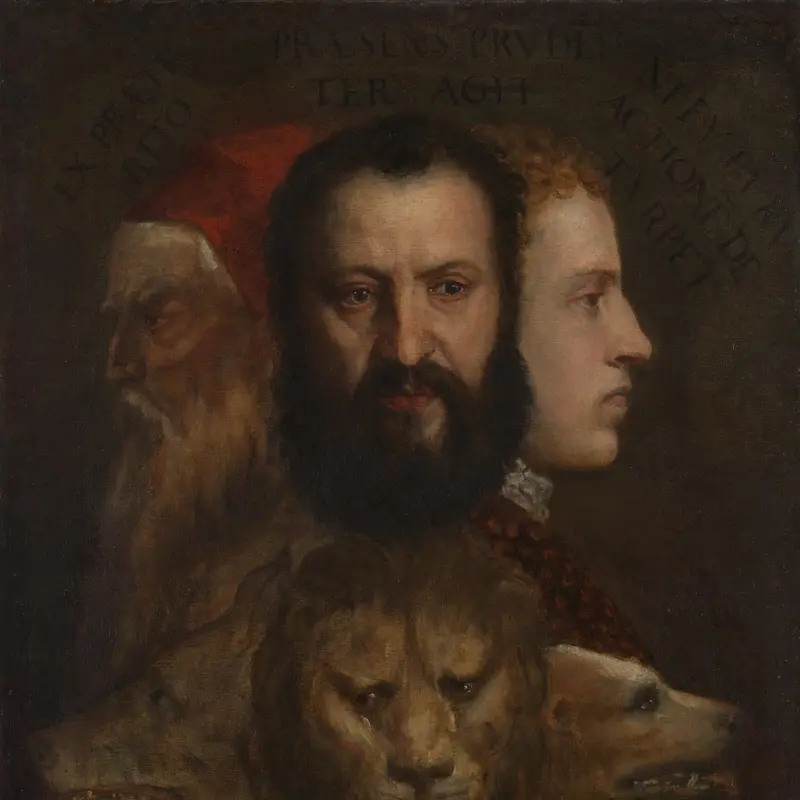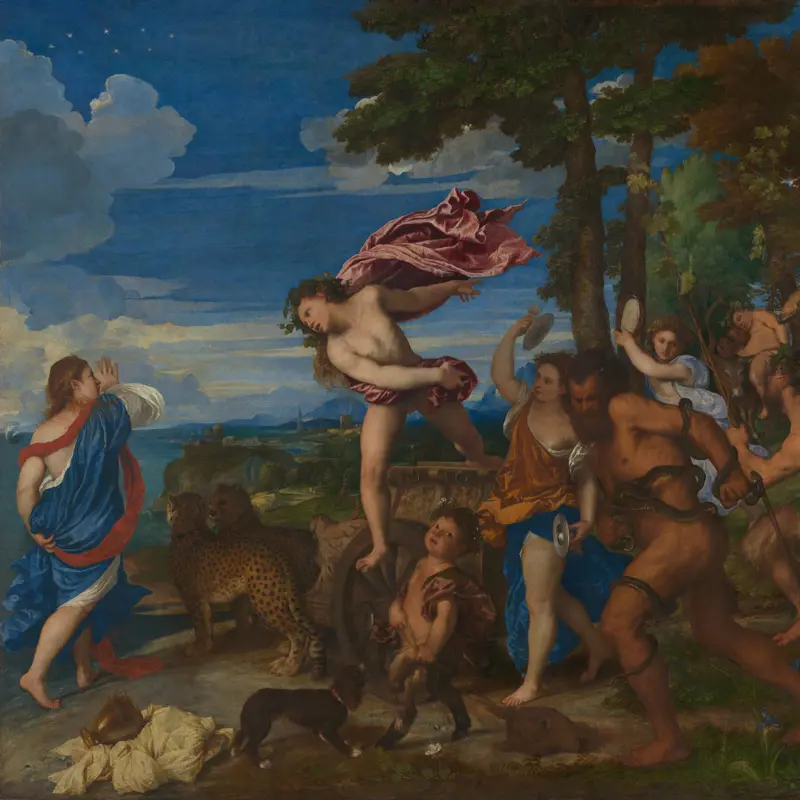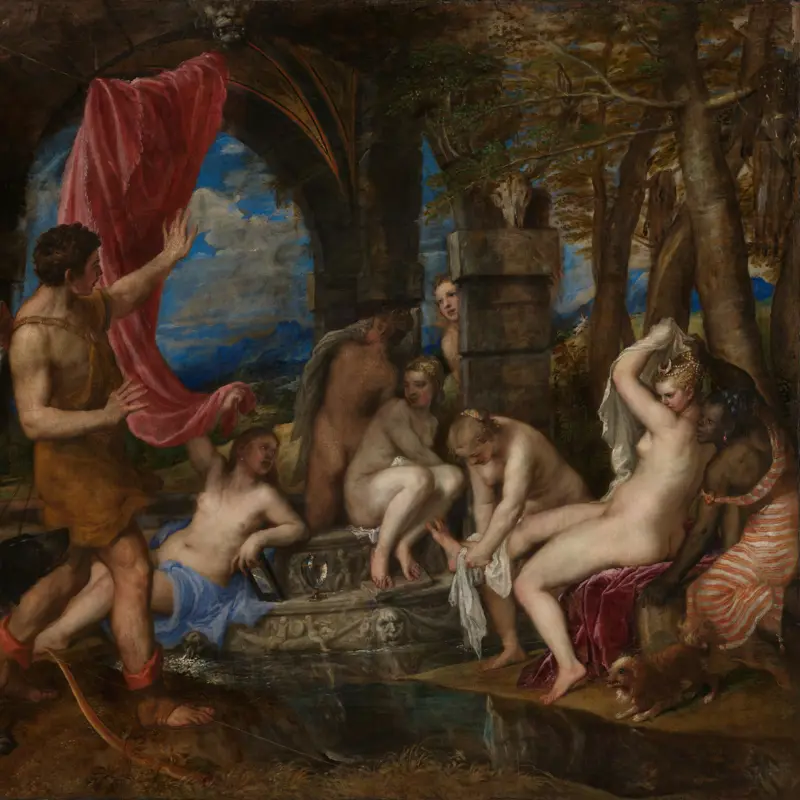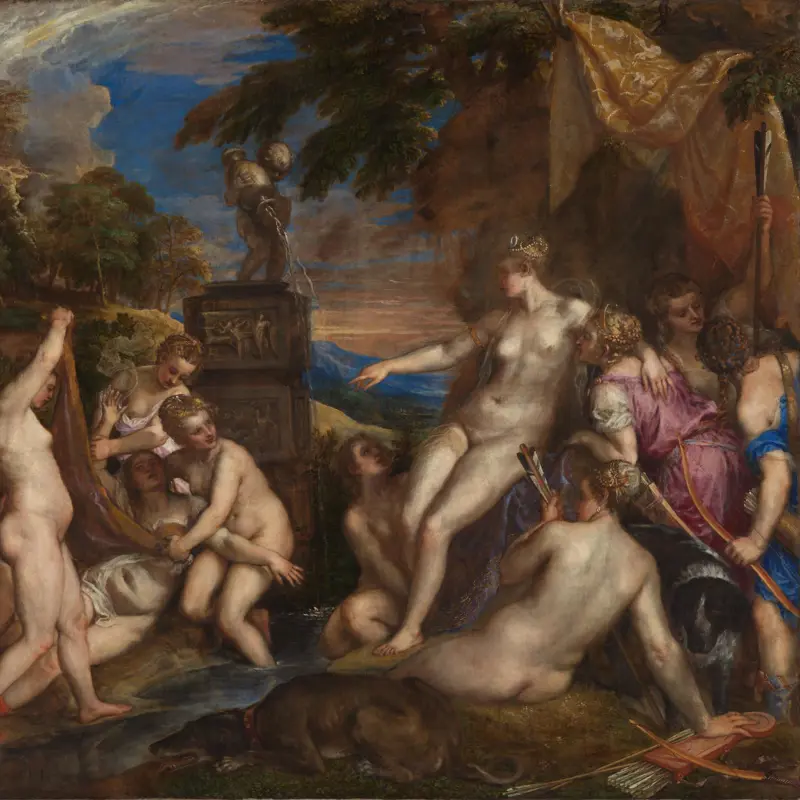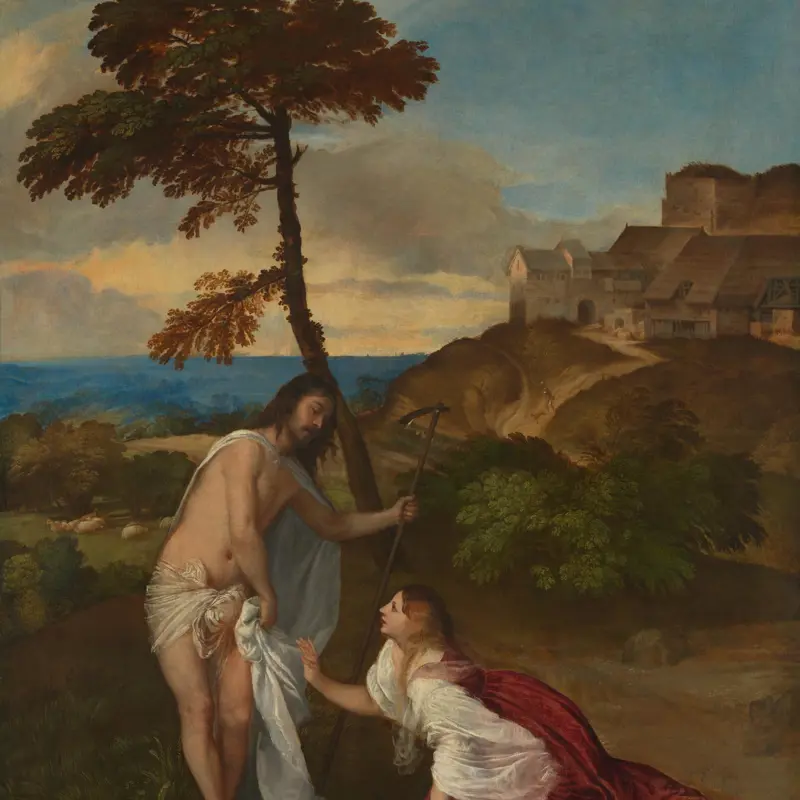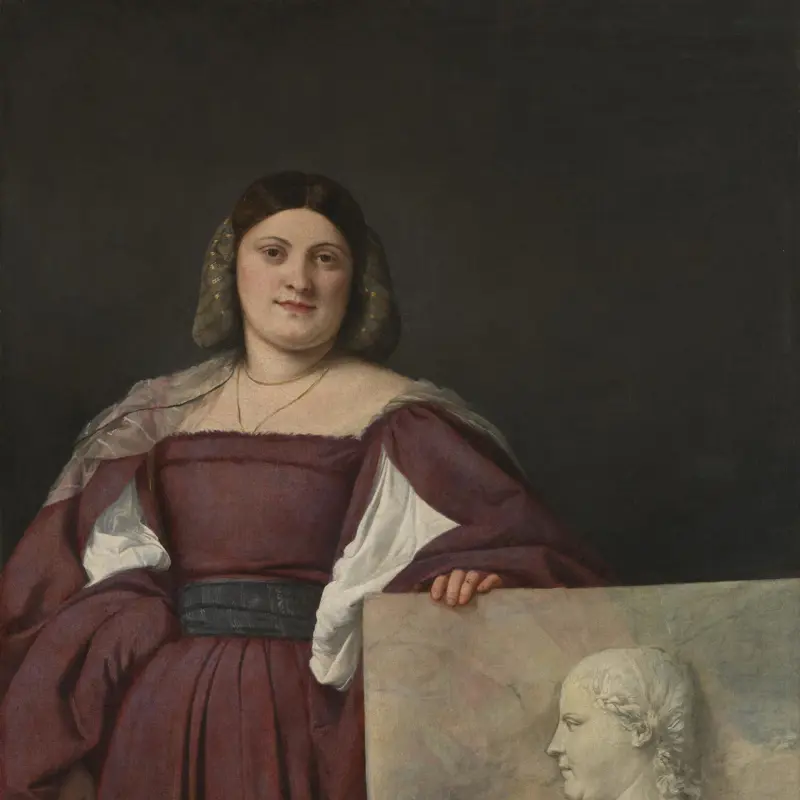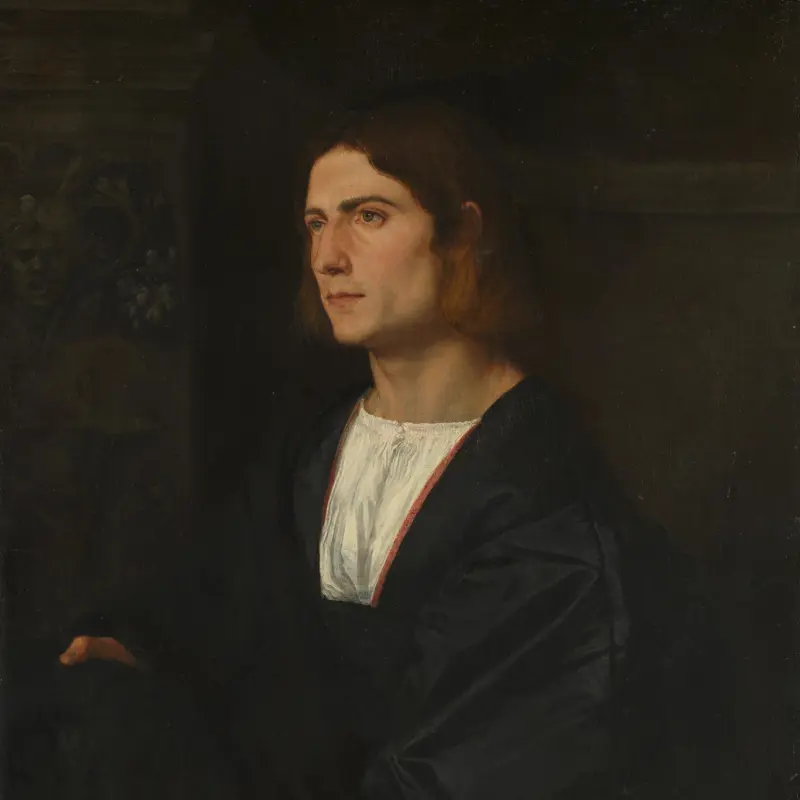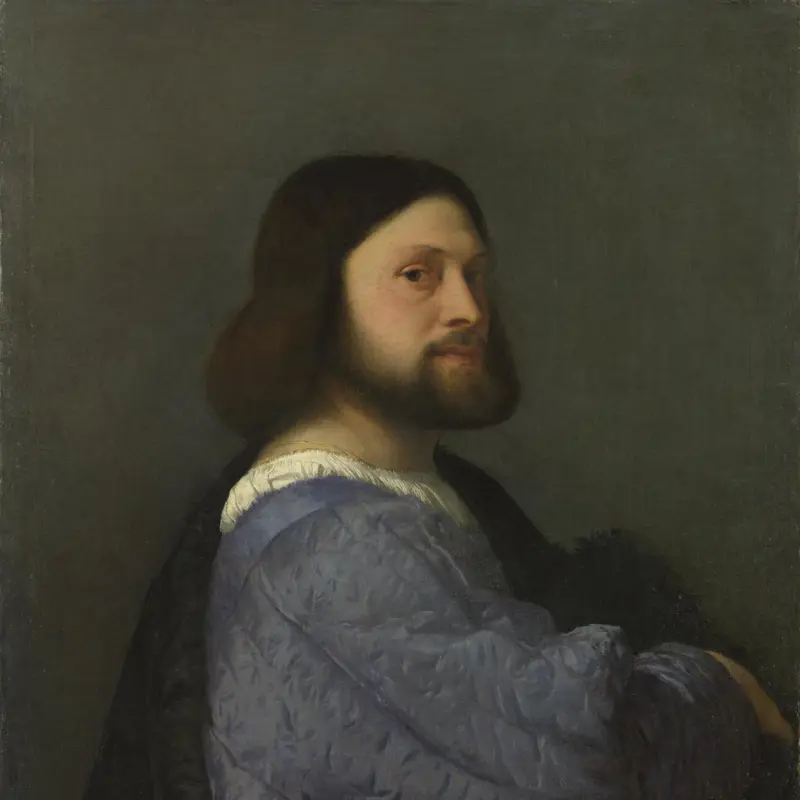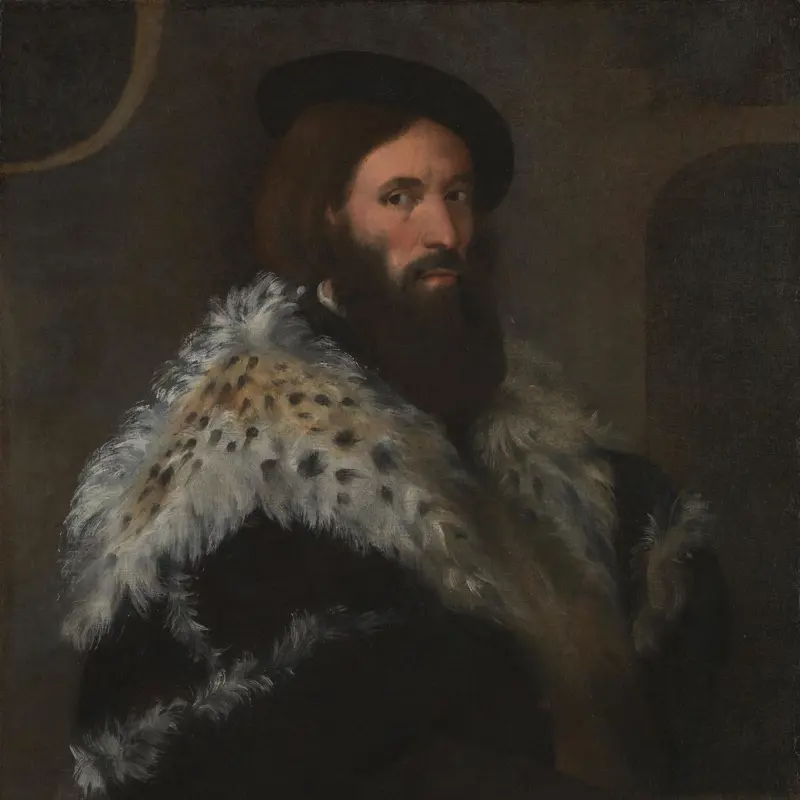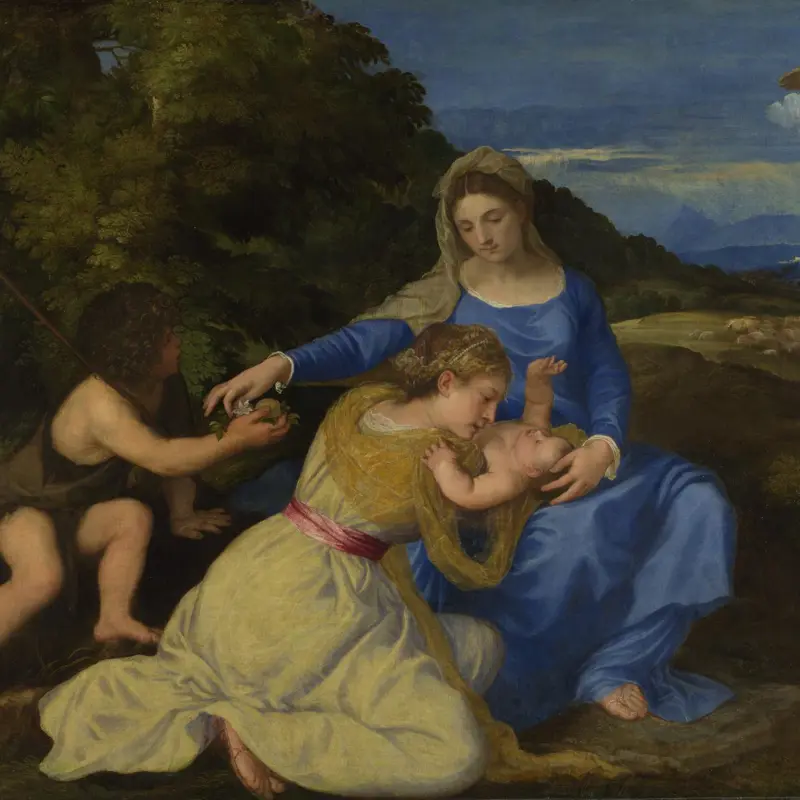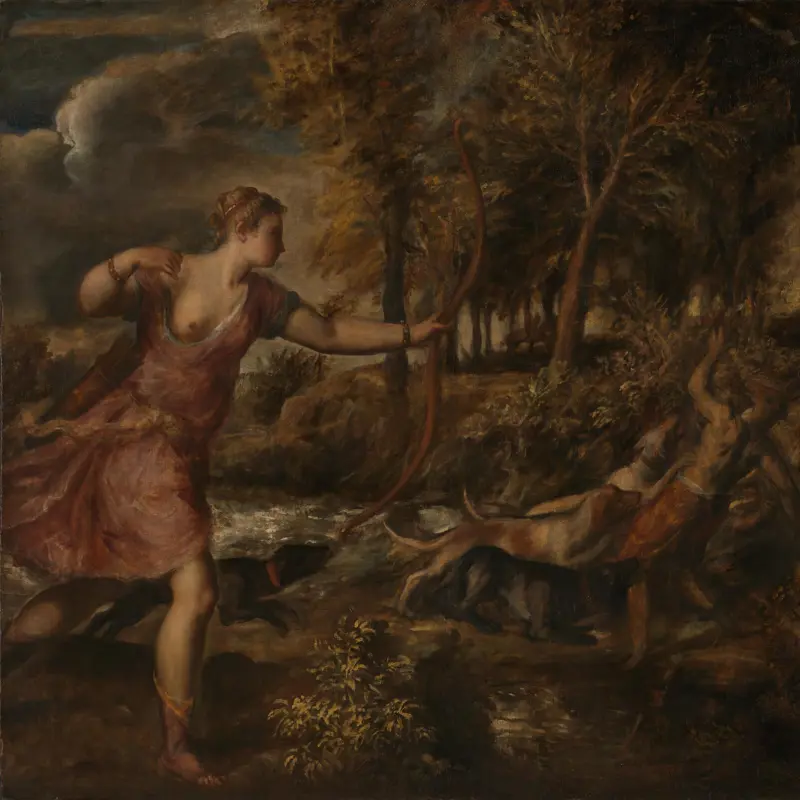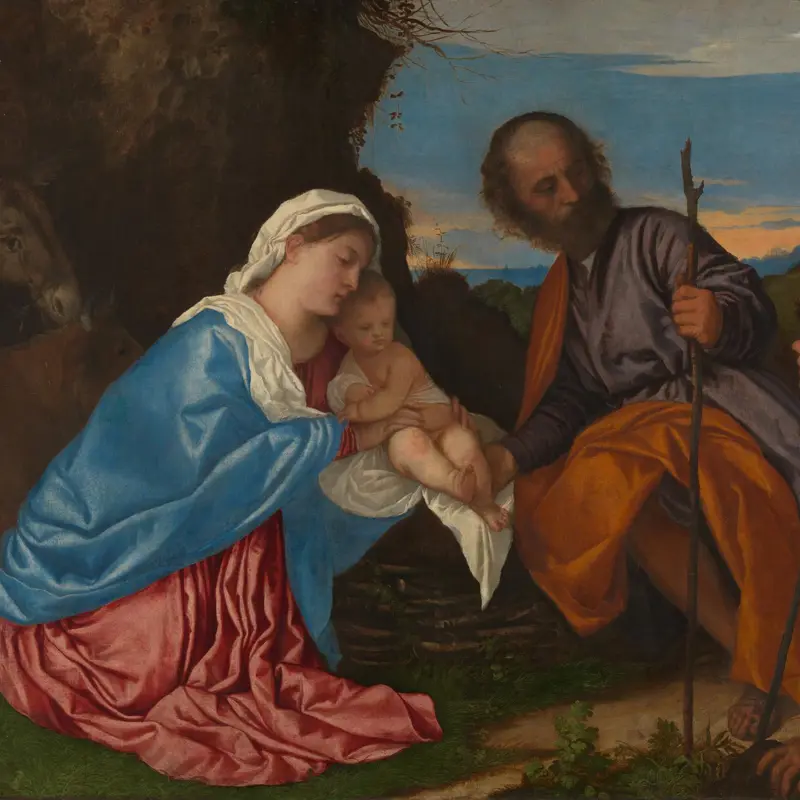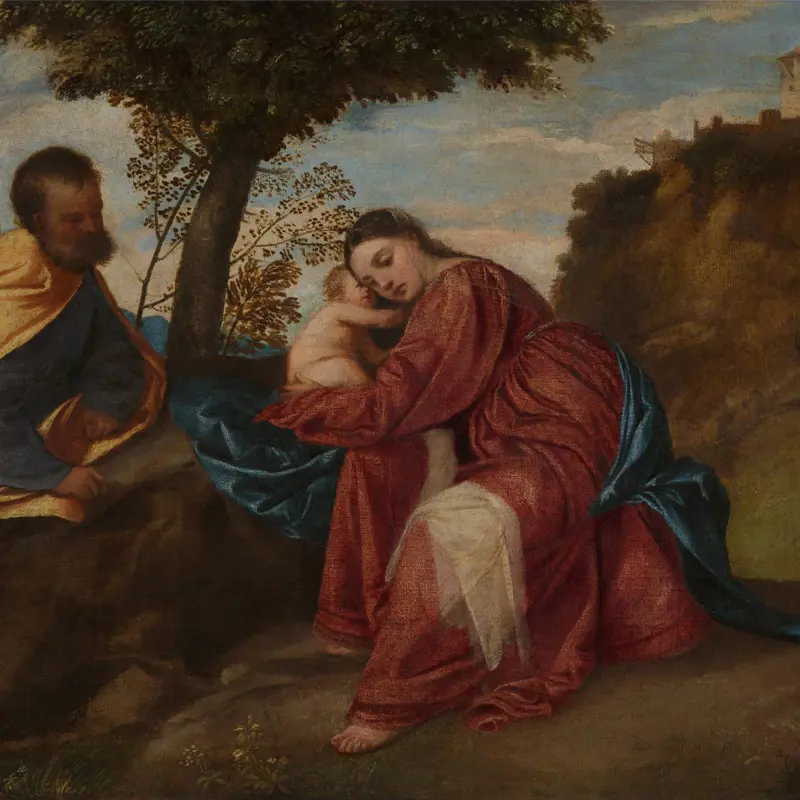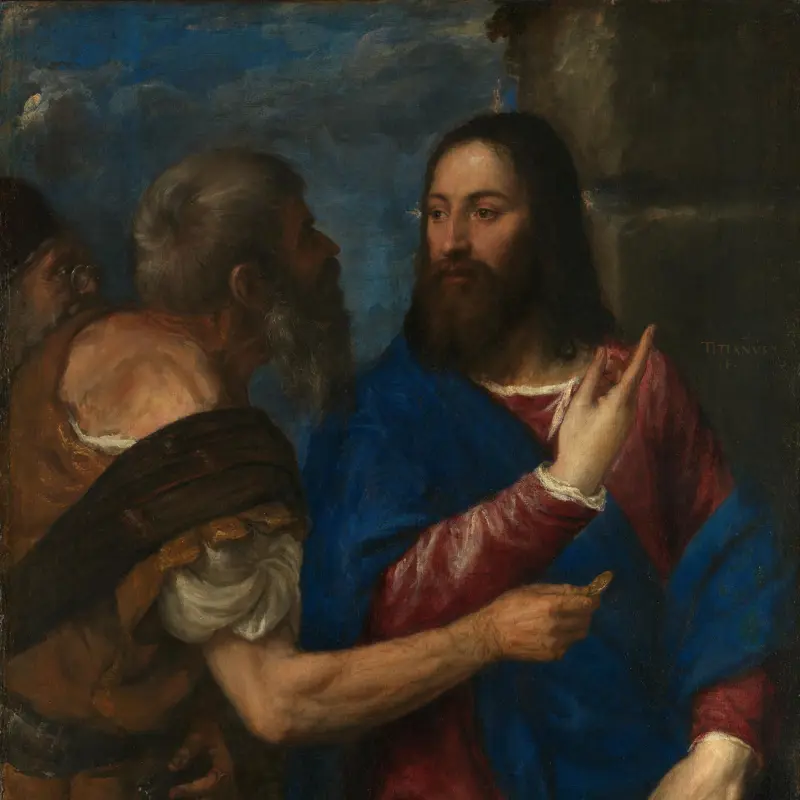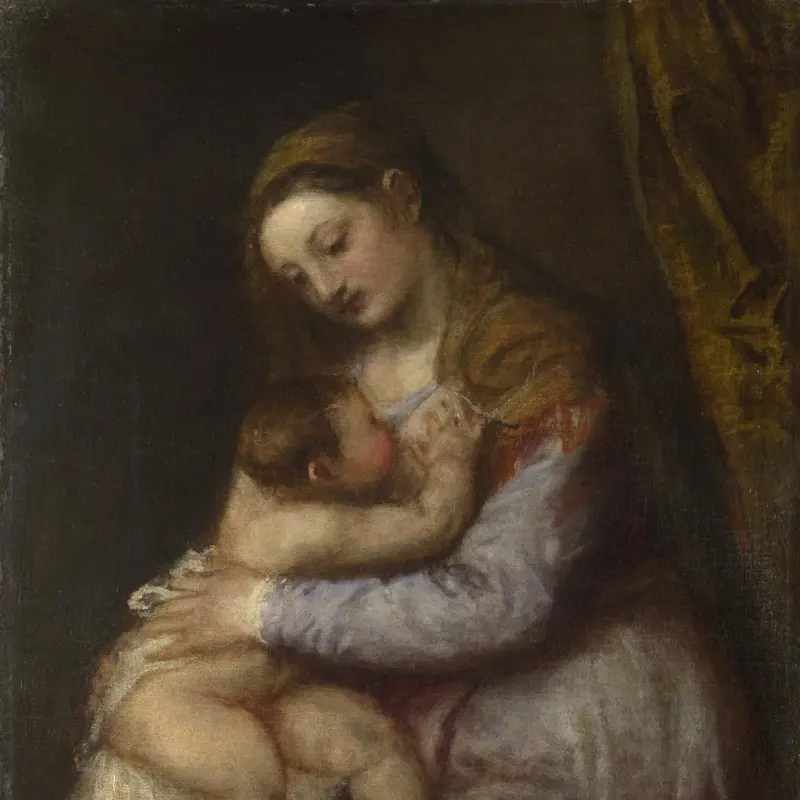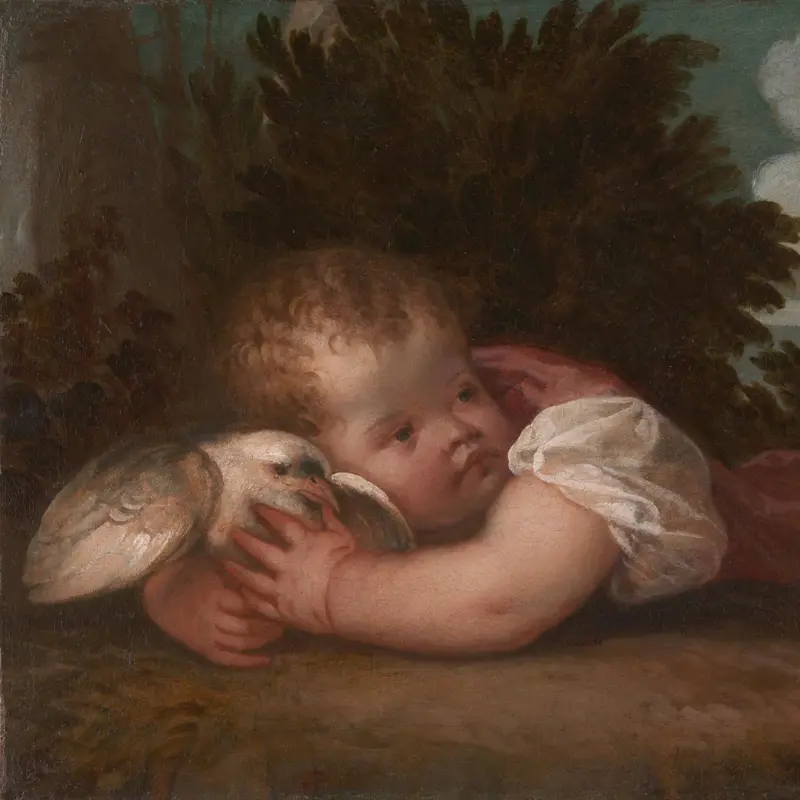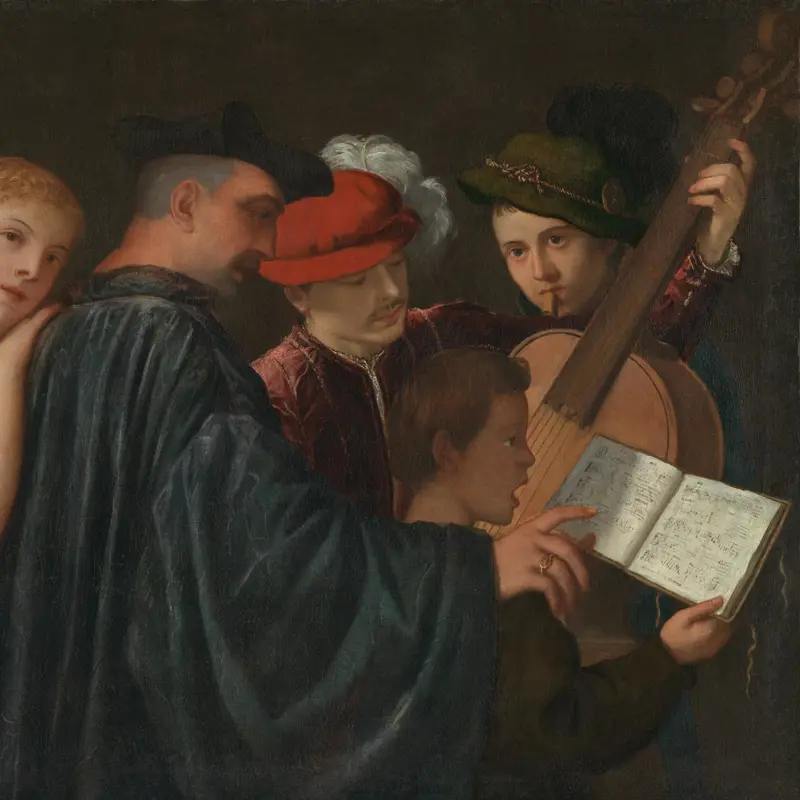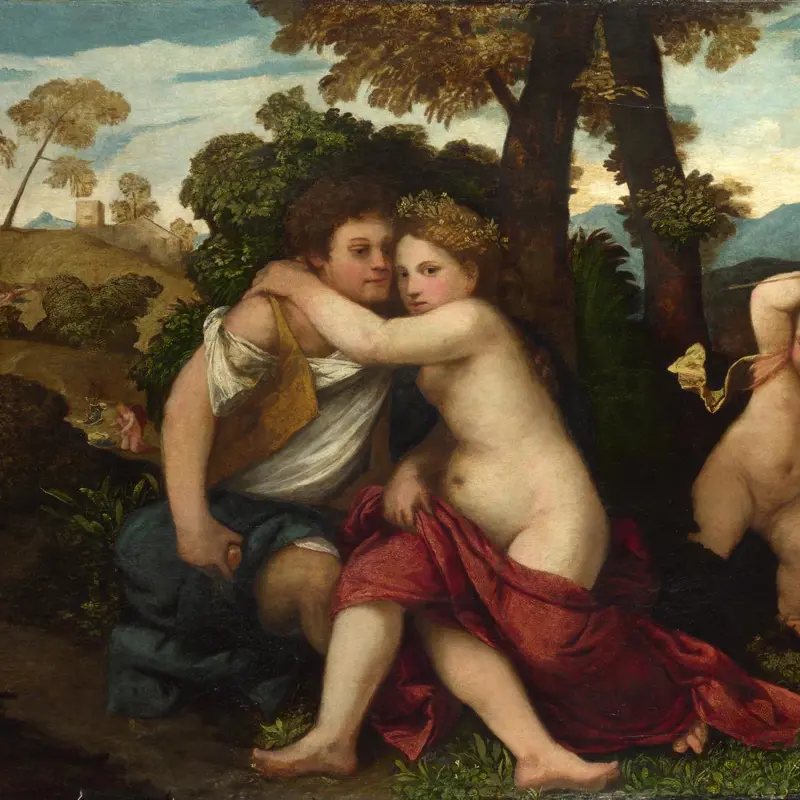Workshop of Titian, 'Venus and Adonis', about 1554
About the work
Overview
Naked Venus, the goddess of love, throws her arms around handsome young Adonis to stop him from going out to hunt. The story is told in Book 10 of Ovid’s Metamorphoses. Venus falls in love with the youth Adonis when Cupid accidentally wounds her with one of his arrows. She goes hunting with Adonis but tells him not to pursue the fiercer prey (wolves, bears, lions and boars). One morning when Venus sets out in her sky-borne chariot, Adonis’s hounds rouse a wild boar, which turns on him. Venus hears Adonis’s groans, leaps from her chariot and finds him dying. From her lover’s blood she creates a fragile flower whose petals are scattered in the wind, named anemone (‘wind flower’ in Greek).
This picture is one of many versions of the subject painted by Titian and his studio. The most famous was delivered in 1554 to Prince Philip, later King Philip II of Spain, and is now in the Museo del Prado, Madrid. The National Gallery’s canvas was probably painted by an artist in Titian’s workshop, following his by then established design.
Key facts
Details
- Full title
- Venus and Adonis
- Artist
- Workshop of Titian
- Artist dates
- Active about 1506; died 1576
- Date made
- About 1554
- Medium and support
- Oil on canvas
- Dimensions
- 177.9 × 188.9 cm
- Acquisition credit
- Bought, 1824
- Inventory number
- NG34
- Location
- Not on display
- Collection
- Main Collection
- Previous owners
Provenance
Additional information
Text extracted from the ‘Provenance’ section of the catalogue entry in Nicholas Penny, ‘National Gallery Catalogues: The Sixteenth Century Italian Paintings’, vol. 2, ‘Venice 1540–1600’, London 2008; for further information, see the full catalogue entry.
Exhibition history
-
2012Shakespeare: Staging the WorldThe British Museum19 July 2012 - 25 November 2012
-
2013American Adversaries: West and Copley in a Transatlantic WorldThe Museum of Fine Arts (Houston)29 September 2013 - 19 January 2014
Bibliography
-
1822T.F. Dibdin, Aedes Althorpianae, London 1822
-
1823J. Young, A Catalogue of the Celebrated Collection of Pictures of the Late John Julius Angerstein, Esq: Containing a Finished Etching of Every Picture, and Accompanied with Historical and Biographical Notices, London 1823
-
1824W. Buchanan, Memoirs of Painting: With a Chronological History of the Importation of Pictures by the Great Masters into England Since the French Revolution, London 1824
-
1854G.F. Waagen, Treasures of Art in Great Britain: Being and Account of the Chief Collections of Paintings, Drawings, Sculptures, Illuminated Mss. […], vol. 2, trans. E. Eastlake, London 1854
-
1877J.A. Crowe and G.B. Cavalcaselle, Titian: His Life and Times, London 1877
-
1922J. Farington, The Farington Diary, ed. J. Greig, 8 vols, London 1922
-
1924C. Holmes, 'Titian's Venus and Adonis in the National Gallery', The Burlington Magazine, XLIV/250, 1924, pp. 16-22
-
1936H. Tietze, Titian: Leben und Werk, 2 vols, Vienna 1936
-
1946E. Tietze-Conrat, 'Titian's Workshop in His Late Years', Art Bulletin, XXVIII/2, 1946, pp. 76-88
-
1957B. Berenson, Italian Pictures of the Renaissance: A List of the Principal Artists and Their Works, with an Index of Places: Venetian School, 2 vols, London 1957
-
1959Gould, Cecil, National Gallery Catalogues: The Sixteenth Century Venetian School, London 1959
-
1960F. Valcanover, Tutta la pittura di Tiziano, Milan 1960
-
1969R. Pallucchini, Tiziano, Florence 1969
-
1969E. Panofsky, Problems in Titian, Mostly Iconographic, New York 1969
-
1969H.E. Wethey, The Paintings of Titian: The Religious Paintings, 3 vols, London 1969
-
1975D. Rosand, 'Titian and the "Bed of Polyclitus"', The Burlington Magazine, CXVII/865, 1975, pp. 242-5
-
1976M.C. Tanner, Titian, the Poesie for Philip II, Phd Thesis, New York University 1976
-
1977J. Mills and R. White, 'Analyses of Paint Media', National Gallery Technical Bulletin, I, 1977, pp. 57-9
-
1981J.C. Nash, Poesie for Philip II, Phd Thesis, John Hopkins University 1981
-
1987Gould, Cecil, National Gallery Catalogues: The Sixteenth Century Italian Schools, London 1987
-
1988A. Gentili, Da Tiziano a Tiziano: Mito e allegoria nella cultura veneziana del Cinquecento, Rome 1988
-
1990L. Freedman, 'A Nereid from the Back: On a Motif in the Italian Renaissance Art', Storia dell'arte, LXX, 1990, pp. 323-36
-
1993'Acquisitions 1992', J. Paul Getty Museum Journal, XXI, 1993, pp. 101-63
-
1996W.R. Rearick, 'Titian's Later Mythologies', Artibus et historiae, XVII/33, 1996, pp. 23-67
-
1996M. Brock, 'Titien et Véronèse Adonis à l'épreuve de Vénus', in F. Siguret (ed.), Andromède, ou, le héros à l'épreuve de la beauté: Actes du colloque international, Paris 1996, pp. 225-51
-
1997R. Goffen, Titian's Women, New Haven 1997
-
1998S. Cohen, 'Animals in the Paintings of Titian: A Key to Hidden Meanings', Gazette des beaux-arts, CXL/132, 1998, pp. 193-212
-
1998F. Russell, 'Venus and Adonis', Christie's Magazine, 1998, pp. 38-9
-
1998J. Wood, 'Peter Oliver at the Court of Charles I: New Drawings and Documents', Master Drawings, XXXVI/2, 1998, pp. 123-53
-
1999E.J. Sluijter, 'Emulating Sensual Beauty: Representations of Danaë from Gossaert to Rembrandt', Simiolus, XXVII/1-2, 1999, pp. 4-45
-
1999B.D. Sutherl, 'A Subtle Allusion in Titian's Venus and Adonis Paintings', Venezia cinquecento, IX/17, 1999, pp. 37-52
-
2000P. Costamagna, 'La collection de peintures d'une famille florentine établie à Rome: L'Inventaire après décès du duc Anton Maria Salviati dressé en 1704', Nuovi studi, V/8, 2000, pp. 177-233
-
2001
C. Baker and T. Henry, The National Gallery: Complete Illustrated Catalogue, London 2001
-
2001F. Pedrocco, Titian: The Complete Paintings, London 2001
-
2001V. Rosen, '"Diletto dei sensi" und "diletto dell'intelletto". Bellinis und Tizians "Bacchanalien" für Alfonso d'Este in ihrem Rezeptionskontext', Städel-Jahrbuch, XVIII, 2001, pp. 81-112
-
2002S. Bracken, 'Copies of Old Master Paintings in Charles I's Collection: The Role of Michael Cross (fl.1632-60)', British Art Journal, III/2, 2002, pp. 28-31
-
2003J. Habert, 'The So-Called "Pardo Venus": A Farewell to Giorgione', Apollo, CLVII/496, 2003, pp. 46-54
-
2003K. Hosono, 'Venere e Adone di Tiziano: La scelta del soggetto e le sue fonti', Venezia cinquecento, XIII/26, 2003, pp. 111-62
-
2004A. Ávila, 'Venus y Adonis durmiendo a proposito de Pablo Veronés', Anuario del Departamento de Historia y Teoría del Arte, XVI, 2004, pp. 73-90
-
2004J. Lawson, 'Titian's Diana Pictures: The Passing of an Epoch', Artibus et historiae, XXV/49, 2004, pp. 49-63
-
2005A. Bayer, 'North of the Apennines: Sixteenth-Century Italian Paintings in Venice and the Veneto: The Triumvirate: Titian, Veronese, and Tintoretto', Metropolitan Museum of Art Bulletin, LXIII/1, 2005, pp. 6-35
-
2007Élisa de Halleux, "Vénus et Adonis", "colorito" et "disegno": Un idéal amoureux androgyne pour la peinture à l'huile?', Studi tizianeschi, V, 2007, pp. 166-81
-
2008Penny, Nicholas, National Gallery Catalogues: The Sixteenth Century Italian Paintings, 2, Venice, 1540-1600, London 2008
-
2008V. Markova, 'Considerazioni sulla nuova versione del "best seller" di Tiziano: "Venere e Adone"', Arte veneta, LXV, 2008, pp. 145-57
About this record
If you know more about this work or have spotted an error, please contact us. Please note that exhibition histories are listed from 2009 onwards. Bibliographies may not be complete; more comprehensive information is available in the National Gallery Library.

